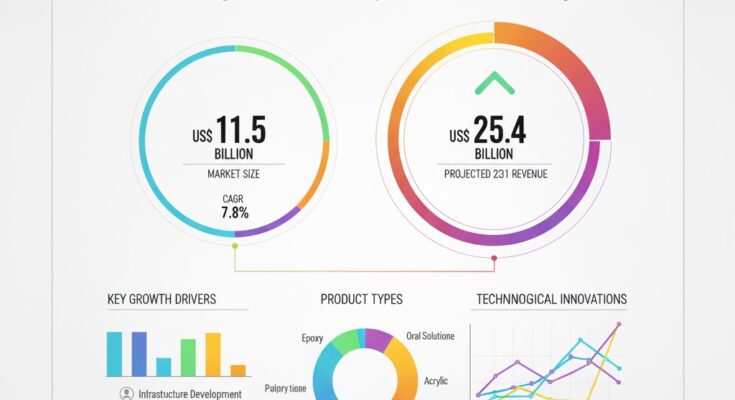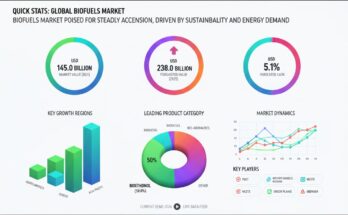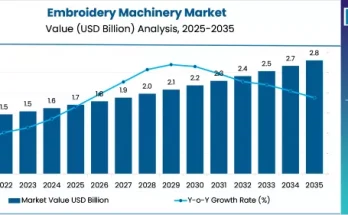The global construction adhesive market is poised for healthy growth through 2031, as rising infrastructure investments, evolving construction practices, and demand for durable bonding materials drive adoption. According to a comprehensive analysis, the market is expected to grow at a compound annual growth rate (CAGR) of around 5% over the forecast period.
Market Overview and Growth Drivers
Construction adhesives are increasingly replacing traditional mechanical fasteners like screws, nails, or bolts in modern structures. Their ability to provide strong, flexible, and resilient bonds makes them indispensable for applications ranging from waterproofing and roofing to panel assembly and woodwork.
Key factors fueling this growth include:
-
Infrastructure and Commercial Construction Boom
Rapid urbanization and large-scale construction projects — particularly in emerging markets — are intensifying demand for bonding solutions that offer efficient installation, strength under load, and long-term durability. -
Demand for Heat- and Moisture-Resistant Adhesives
As buildings become more sophisticated, there’s a growing need for adhesives that can withstand environmental stresses like humidity, temperature changes, and weathering without compromising bond integrity. -
Efficiency and Cost Savings
Adhesives can speed up construction processes, reduce labor costs, and minimize the need for mechanical fixings. For many builders, this means faster project timelines and lower overall costs. -
Performance Innovations
Manufacturers are innovating across formulations — water-based, solvent-based, and reactive technologies — to deliver high-performance adhesives with faster curing times, improved bond strength, and reduced VOC emissions. -
Sustainability Trends
There is increasing demand for green building materials. Adhesives that offer low volatile organic compound (VOC) formulations are gaining preference, especially in markets with strict environmental standards.
Key Market Insights & Segmentation
-
By Resin Type: The major types of resins used in construction adhesives include epoxy, acrylic, cyanoacrylate, polyurethane, and others. Each resin category addresses different bonding needs — for example, epoxy for high-strength applications and acrylics for flexible, general-purpose use.
-
By Technology Type: Adhesives are formulated using water-based, solvent-based, and reactive chemistries, catering to different performance, health, and application requirements.
-
By End-User Segment: The construction adhesive market serves residential, commercial, and infrastructure sectors. Residential construction leverages adhesives for finishing, paneling, and insulation, while infrastructure use demands high-performance bonding for structural components and repair.
-
Regional Outlook: While the market is global, Asia-Pacific has emerged as a key growth engine, fueled by aggressive infrastructure development, rapid urbanization, and expanding construction spending in large economies.
Competitive Landscape
Key players in the construction adhesive market include major chemical and adhesive manufacturers who are investing in R&D and expanding their product portfolios. Some prominent companies are:
-
Henkel
-
3M
-
MAPEI
-
Sika
-
Ardex
These companies are advancing their technologies to bring faster-curing, more durable, and eco-friendlier adhesives to the construction sector. Strategic partnerships with construction firms and green building initiatives further help them maintain competitive advantage.
Market Challenges
Despite positive growth, the market faces a few headwinds:
-
Regulatory & Environmental Compliance: Stricter regulations on VOCs are pushing manufacturers to reformulate adhesives without compromising performance.
-
Raw Material Volatility: Fluctuations in the cost of resin and solvent raw materials can impact profitability and pricing strategies.
-
Adoption of New Technologies: While advanced adhesives offer performance benefits, educating contractors and builders on proper use remains a barrier, especially in regions still relying on traditional mechanical methods.
Future Outlook & Trends
Looking ahead, the construction adhesive market is expected to evolve in the following ways:
-
Green Adhesives Growth: Low-VOC and bio-based adhesives will become more mainstream, driven by regulation and builder preference for sustainable materials.
-
Prefabricated and Modular Construction: As modular building gains traction, adhesives will play a central role in panel bonding, joint sealing, and structural integrity.
-
Smart & Reactive Adhesives: There is increasing interest in adhesives that cure rapidly, respond to environmental triggers (e.g., moisture), or self-heal, improving longevity and ease of application.
-
Digital Adoption: Integration with digital construction workflows (BIM, prefabrication planning) may drive custom adhesive solutions optimized for automated and off-site building processes.
Browse Full Report : https://www.factmr.com/report/construction-adhesive-market
About Fact.MR
Fact.MR is an independent market research and consulting firm committed to delivering forward-looking, data-driven insights across a variety of industries. Their rigorous analysis supports business leaders in making strategic and evidence-based decisions.



